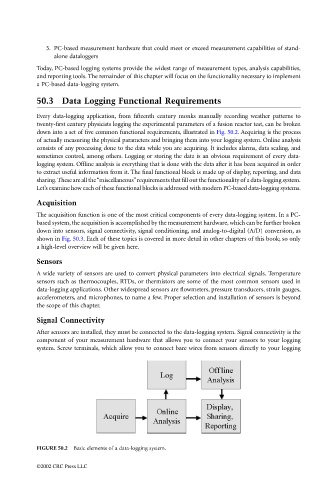Page 1225 - The Mechatronics Handbook
P. 1225
3. PC-based measurement hardware that could meet or exceed measurement capabilities of stand-
alone dataloggers
Today, PC-based logging systems provide the widest range of measurement types, analysis capabilities,
and reporting tools. The remainder of this chapter will focus on the functionality necessary to implement
a PC-based data-logging system.
50.3 Data Logging Functional Requirements
Every data-logging application, from fifteenth century monks manually recording weather patterns to
twenty-first century physicists logging the experimental parameters of a fusion reactor test, can be broken
down into a set of five common functional requirements, illustrated in Fig. 50.2. Acquiring is the process
of actually measuring the physical parameters and bringing them into your logging system. Online analysis
consists of any processing done to the data while you are acquiring. It includes alarms, data scaling, and
sometimes control, among others. Logging or storing the data is an obvious requirement of every data-
logging system. Offline analysis is everything that is done with the data after it has been acquired in order
to extract useful information from it. The final functional block is made up of display, reporting, and data
sharing. These are all the “miscellaneous” requirements that fill out the functionality of a data-logging system.
Let’s examine how each of these functional blocks is addressed with modern PC-based data-logging systems.
Acquisition
The acquisition function is one of the most critical components of every data-logging system. In a PC-
based system, the acquisition is accomplished by the measurement hardware, which can be further broken
down into sensors, signal connectivity, signal conditioning, and analog-to-digital (A/D) conversion, as
shown in Fig. 50.3. Each of these topics is covered in more detail in other chapters of this book; so only
a high-level overview will be given here.
Sensors
A wide variety of sensors are used to convert physical parameters into electrical signals. Temperature
sensors such as thermocouples, RTDs, or thermistors are some of the most common sensors used in
data-logging applications. Other widespread sensors are flowmeters, pressure transducers, strain gauges,
accelerometers, and microphones, to name a few. Proper selection and installation of sensors is beyond
the scope of this chapter.
Signal Connectivity
After sensors are installed, they must be connected to the data-logging system. Signal connectivity is the
component of your measurement hardware that allows you to connect your sensors to your logging
system. Screw terminals, which allow you to connect bare wires from sensors directly to your logging
FIGURE 50.2 Basic elements of a data-logging system.
©2002 CRC Press LLC

